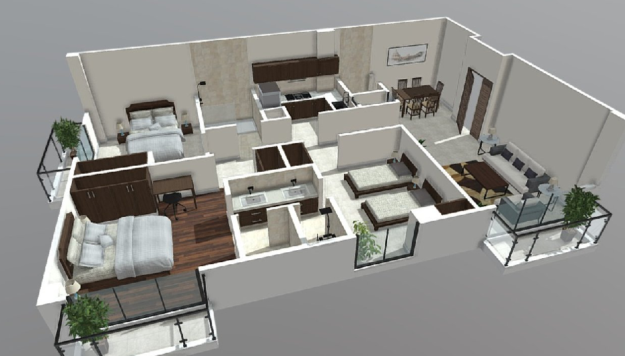Futuristic 3D technology vows to revolutionise the Pakistani real estate sector
Are you on the lookout for a home in a different city? Imagine taking a tour of all your options without having to travel at all. This is possible with 3D modelling, which has made its mark in the real estate market all over the world.
The best part is that these 3D models are not just marketing gimmicks, they actually have numerous benefits for all parties involved. Agents and developers can greatly improve their business models if they use 3D modelling technologies as it puts them in a leading market position. In addition to that, it also has the potential to attract numerous customers.
Instead of showing customers a few properties over a number of days, agents can now present them with a wide range of options right in their office. In doing so, they can save significant amounts of resources by making visual 3D models of the listings available online. This in return will also help save on the cost and manpower of property tours for prospective buyers.
Usage of 3D models can assist agents as well as developers in making more informed and customised decisions. If an apartment or house is incomplete, customers can get an idea of the finished product, along with 3D rendered customisations. One of the local companies that has implemented this new-age technology is the eminent real estate portal Zameen.com
Zameen.com is the only Pakistani brand that offers exclusive virtual 3D tours of various projects online for people to explore from all over the world. This is beneficial for both, the developers and the buyers, and helps improve customer satisfaction.
The practical aspects of 3D modelling are quite vast, and this technology can be helpful with legal matters as well. In the planning stages, developers can create 3D models to ensure that they meet all legal parameters set by the authorities for the property type they are developing. The 3D model can be kept as a record that can be used for future reference as well.
Not just for developers, this technology makes things much easier for customers as well. Whether someone wants to purchase or sell their house, a 3D model can make the process very convenient. Anyone who has sold their house knows how much of a hassle it can be to have people come in and see it. The place has to be kept clean at all times, and not everyone is comfortable having strangers inspect their rooms. But now, with 3D model technology, prospective buyers can explore the property as many times as they want, and can take all the time they need without having to worry about social concerns.
Buyers have to look over a plethora of houses by taking extensive time out of their schedules. With such 3D tools, both buyers and sellers go through the whole process much more easily by saving time and unnecessary hassles. They can explore as many properties as they want, while sellers can get one comprehensive 3D model made, and then wait for customers to snap up their houses.
If someone is purchasing a property in an under-construction project, 3D models can assist them envisioning what the end product might look like. They can customise their units accordingly, and communicate their ideas to the architects and designers involved.
The ‘how-tos’ and ‘what-ifs’ of 3D modelling
Now that we’ve discussed the benefits of 3D models in real estate, let’s talk about how companies can get down to the actual nitty-gritty. There are myriad software programmes that organisations or agencies can use for their design needs. Some of the more popular ones are AutoCAD, 3ds Max, Sketchup and Blender. Out of these, Blender is the only one that is free and open-source, so it’s a good option for individuals, or companies operating on a smaller scale.
The important thing to look out for in 3D models is the fidelity of the image and the field of view. The field of view refers to the observable area in an image. With a 3D model of a house, customers respond best if they have the option to see both the exterior and interiors as a whole, as well as zoom in to assess minute details.
Fidelity, on the other hand, means how close a 3D rendering is to the appearance of the actual materials being represented. For example, does the wood grain in the 3D model accurately represent the woodwork of the house or not. In future, this fidelity might even be represented by sensors that replicate the texture of real materials in virtual 3D models, but the technology still is in a developing phase before it can reach that point
The world of Virtual Reality and Augmented Reality fits perfectly with the real estate industry, and has the potential to revolutionise the sector; making it much more accessible to a larger number of people.
Futuristic 3D technology vows to revolutionise the Pakistani real estate sector
 Reviewed by AL-MANSOOR TECH
on
October 25, 2019
Rating:
Reviewed by AL-MANSOOR TECH
on
October 25, 2019
Rating:
 Reviewed by AL-MANSOOR TECH
on
October 25, 2019
Rating:
Reviewed by AL-MANSOOR TECH
on
October 25, 2019
Rating:









No comments: